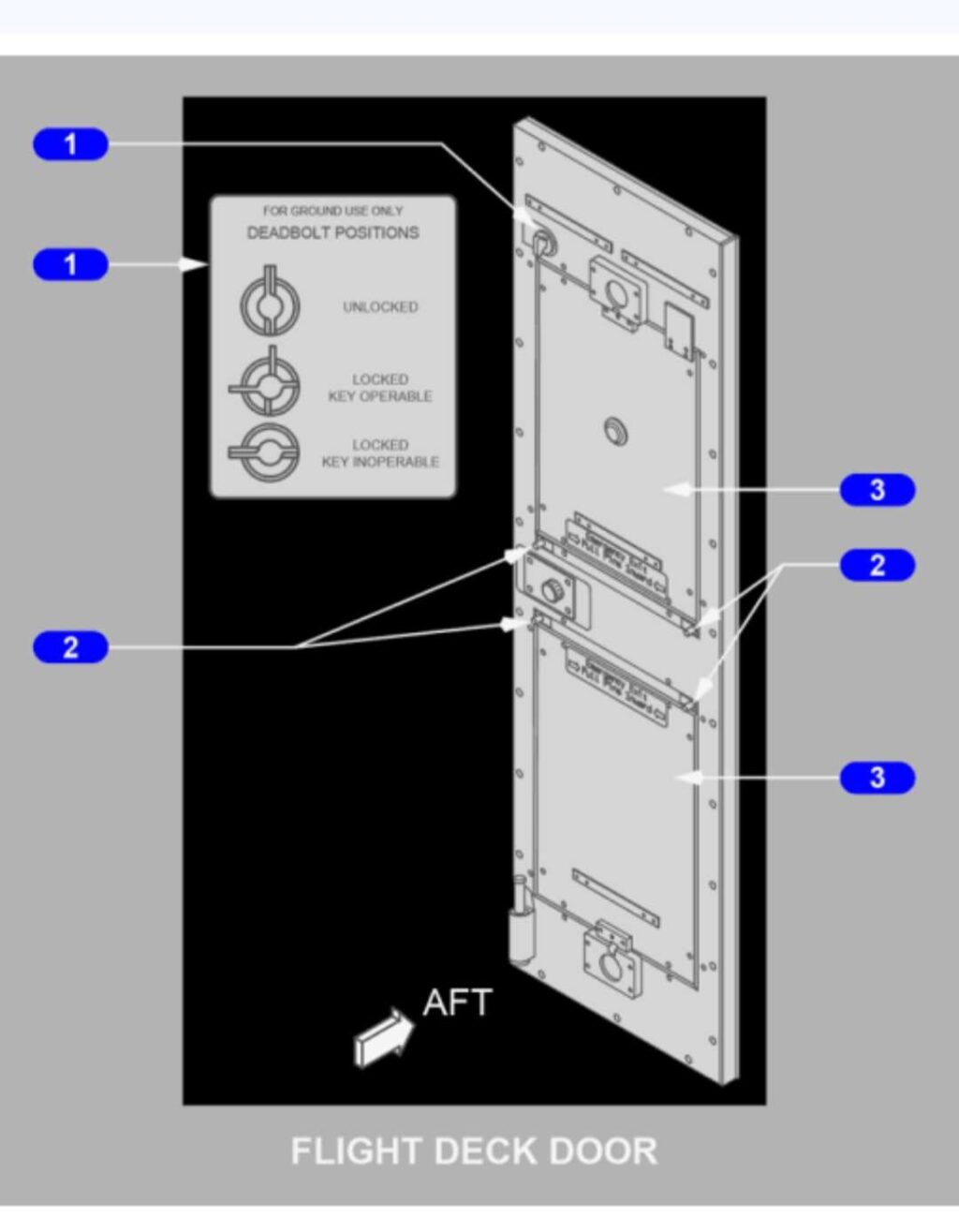
The crew of Alaska Airlines 1282 was startled. The chair of the National Transportation Safety Board was annoyed. Headlines accused Boeing of keeping yet another secret from pilots. But the design that allows the cockpit door to open in case of a significant loss of pressure is not new, nor is it unique to the Max. It is common on nearly all airliners made by Boeing and Airbus.
Since the mid-2000s, plane makers have patented relatively simple devices that override the cockpit electronic door locks installed as a result of September 11th security concerns. The devices activate in response to an abrupt loss of pressure from the passenger cabin. This is what happened after a door plug came off at 16-thousand feet on the Alaska flight out of Portland, Oregon on January 5th.
It would have worked the same way on Qantas Flight 30, a Boeing 747 that depressurized when an oxygen bottle exploded and shot like a missile through the side of the passenger cabin in 2008.

Opening the door to the cockpit in events like this “allows the venting of the cabin area” to “relieve the now higher pressure on the cockpit/cabin bulkhead therein,” according to one of the patent applications sought by Boeing.
“Having the door pop open relieves that pressure,” one pilot told me as we discussed the feature.
In my book, The Crash Detectives, I spend quite a bit of time reporting on the various ways airplanes can depressurize. In the case of the cockpit door opening mechanism, what is important to understand is where in the fuselage the breach occurs. If it happens behind the cockpit as in Alaska and Qantas, air races out the hole including air in the cockpit. If the closed cockpit door restricts the flow of air, the pressure can stress the airplane structure.
When the breach happens in the cockpit, decompression panels on hinges swing open, allowing a path for the pressurized air in the cabin to to exit through the cockpit. The cockpit door remains shut. So to be clear, the unlocking of the door happens only to equalize the pressure when the opening is behind the cockpit.

Don’t spend hours, as I did, combing the pilot forums or Reddit or Quora about this because you are certain to discover many conflicting claims and a whole lot of nonsense. What is important to note is that when depressurization happens in the cabin it can trigger the cockpit door to unlock. Many pilots don’t know this.
Why the secrecy? Boeing had no comment and Airbus and the NTSB did not reply to questions. My research shows however that it is not – as has been portrayed – some conspiracy by Boeing to keep pilots in the dark.
 Earlier in the week, I called an acquaintance who specializes in safety to find out if he was aware of the ubiquity of the technology. He was not. He was mildly upset about it because there is a process in the United States at least, for confidentially sharing with pilots what is called “sensitive security information.” This had not been shared.
Earlier in the week, I called an acquaintance who specializes in safety to find out if he was aware of the ubiquity of the technology. He was not. He was mildly upset about it because there is a process in the United States at least, for confidentially sharing with pilots what is called “sensitive security information.” This had not been shared.
“It’s one of those things, we can’t affect it,” the pilot, who asked to remain unidentified, told me. “We can’t change it. We can’t stop it, so why are we getting uptight about something that is there to protect the airplane?”
Other pilots are less sanguine. “When you’re not informing pilots about the way the plane operates in normal and emergency conditions you have a problem,” said Dennis Tajer, a pilot with American and a representative of the pilots’ union. He was mystified that though crews train for depressurization emergencies, this piece of relevant information is withheld.
“My manual states the pressure sensors unlock the decompression panels, not the door lock itself. There is no mention of anything that will automatically trigger the door to unlock,” a pilot for another airline weighed in.
Considering the security concerns following the commandeering and crashing of 4 airliners in the September 11th attacks, it is likely that the decision to keep the news from pilots came from security officials in the US and perhaps other nations as well.

Safety and security sometimes conflict and this appears to be a perfect example. The lack of information reduced the subject to the level of hangar talk. And here we are with even experienced pilots, former military pilots, ambidextrous pilots (proficient on both Airbus and Boeing) pilots certified to carry weapons on airplanes (FFDOs) and pilots with significant experience in safety who do not know about the door opening even on the airplanes they fly.
“If there is a security threat of the door popping open during decompression, would it be better to have the crew taken by surprise or have them at least think about it beforehand?”, asked John Gadzinski, a 737 pilot and a safety consultant. “I call bullshit that they kept it a secret. Tell your crews the truth and train them well.”
The 9/11 attacks created a need for impenetrable cockpits. For nearly 2 decades, flight decks have been protected by heavy, ballistic-resistant doors that lock and cannot be opened without a pilot releasing the door from the inside or entering a passcode from the outside. Except now you know that there is a third mechanism, physics.

Author of The New York Times bestseller, The Crash Detectives, I am also a journalist, public speaker and broadcaster specializing in aviation and travel.









Excellent piece of journalism. No, I didn’t know, either, though it certainly makes sense that there would be a pressure-equalizing mechanism.
But, the door lock? Surprise, eh?
Great article, I’ve flown Airbus since 2000’s , previously Boeing 200/ Fk50 and Boeing 3/400 series Efis, the Airbus blowout panels in the cockpit door were a pre 9-11 design feature which works effectively and still provides door entrance security.
Having worked previously in engineering, before flying, I’ve noted the lack of true evolution of US aviation design versus Eu iterations in both fixed wing and rotor, unless your looking at sectors of Military development where budget constraints are not limiting.
Ok. You got me. I never heard of this either. But as you said it makes perfect sense. So why not just tell pilots during training? I guess Boeing again has bigger problems on its hands right now, don’t they?
Suddenly it becomes very clear how someone had access to the cockpit after the pilots of MH370 were lost due to hypoxia following explosive decompression as a consequence of lithium battery fire in cargo hold No 1!
So what about if the pilot had engaged the anti-hijack dead bolts? Would the door still open in the event of a main cabin depressurization?
Iam a career pilot with over 26,000 flight hours and have flown both Airbus and Boeing aircraft. Your point that pilots “really dont need to know that the cockpit door can open” during a cabin decompression is misguided!
During a decompression (which I have seen twice in my career) the pilots first move to to turn away from the cockpit door, toward the side windows and don our oxygen masks. Then figure out what is going on “awareness factor time”, what has caused the decompression? Did a cargo door open (structural failure) Did a main tire explode in the wheel well, Has a cabin window blown out, is an engine getting ready to come apart? We make this determination and react to solve the problem and begin an emergency descent! However if the cabin door flies open what will I think? Did I hear an explosion (gun going off) or what I’d surmise that someone is coming through the cockpit door and why and what is happening???
Our training tells us that something bad is happening, so I’d probably turn to the right first toward the c-pit door in a defensive motion, hoping that my co-pilot is donning his/her mask. Ive missed valuable time, the of useful consciousness (TUC) at 35,000 ft is approximately 30 seconds Ive just used up my time defending the cockpit!
My training should have informed me and the other 250 thousand other pilots, that this can happen>
I appreciate hearing your thoughts and I appreciate your considerable experience. You have, however, misattributed someone else’s comment to me. I took no position on whether this was a good or bad idea. I welcome the opinions of my readers, including yours.
Too bad the German Wings pilot didn’t now that
Does this mean that you could penetrate into the cockpit (see case Germanwings 9525 in France) if you provoked a decompression in the cabin (and then the locked door would jump open)?
Theoretically, yes. Practically, it would be difficult to create a rapid depressurization from the passenger cabin without the kinds of tools/weapons that are not allowed to be carried on board. In the case of someone bringing a weapon or explosive device to create a rupture in the cabin, then the situation would be sufficiently grave to make entering the cockpit somewhat moot.
I heard about the cockpit door opening from the NTSB press conference after the Alaska Airlines incident. What I want to know is: once the cockpit door flies open after a depressurization event behind the cockpit (in the cabin) does it remain unlocked even after the pressure equalizes? If a crew member were nearby would it be possible to close & lock the door immediately afterwards or is it designed to remain unlocked until some condition is satisfied?
– Great article by the way!